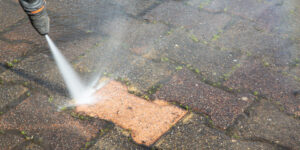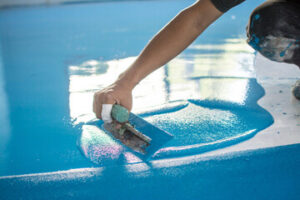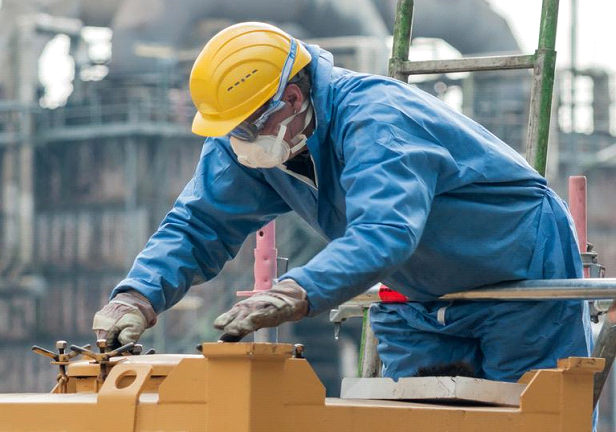Pressure Washing is a quick and easy way to remove built-up grime, mildew and mold from surfaces. It also helps to lengthen the life of your paint job.

Before using a pressure washer, read and familiarize yourself with the machine’s settings and recommended safety precautions. Ensure you have the correct nozzle for your surface and start on a small area first to test the pressure. Visit Website to learn more.
The exterior surfaces of homes, businesses, and industrial properties can become dirty and discolored over time, which detracts from the overall look and feel of a space. Pressure washing is a fast and effective way to remove this buildup, leaving surfaces clean and free from unsightly stains. Regular pressure washing can also prevent the growth of damaging contaminants like mildew, mold, and algae.
Leaving these contaminants unchecked can cause damage to outdoor surfaces, such as rot, rust, and staining. By regularly pressure washing surfaces, you can avoid these costly repairs and extend the lifespan of your outdoor spaces.
Pressure washing is a safe and effective cleaning method for a variety of different surfaces, including concrete, brick, asphalt, wood, stucco, and vinyl siding. However, it is important to use the correct settings and techniques when using a pressure washer, as too much water pressure can damage certain materials. Professionals are trained to know the right psi, water rotation, and cleaning products to use for each surface type.
Regularly washing the exterior of your home or business can also help to boost curb appeal and create a more welcoming environment for guests and customers. Dirt, mud, mold, mildew, and other contaminants can eat away at the surfaces of your property and create a dull, uninviting appearance. Pressure washing can remove these contaminants and restore the beauty of your outdoor spaces, making them more attractive to guests and potential customers.
Investing in regular pressure washing can also help to increase the value of your property. A dirty, unkempt exterior can make potential buyers assume that the interior of your home or business is equally dirty and neglected. Pressure washing can remove dirt, mud, and grime from surfaces, ensuring that they are in good condition before applying any new materials or paints.
Increased Property Value
If you plan to sell your home in the future, professional pressure washing can help to increase its value by preventing damage and preserving materials. This process removes black stains, mold, mildew, and lichens that can degrade the appearance of your roof, siding, driveway, deck, and walkways. In addition, it reduces the risk of costly repairs and replacements.
A clean exterior makes your home more appealing to potential buyers and can help to speed up the selling process. Studies have shown that homes with high curb appeal sell 7% faster and for 5-10% more than those with neglected exteriors. A professional pressure wash is a cost-effective way to boost your home’s curb appeal.
Regular maintenance and cleaning can also extend the life of your siding, roof shingles, windows, fences, and other outdoor surfaces. It helps to prevent mold, mildew, and rot from developing, which can save you money on expensive repair and replacement costs. By removing dirt, oil, and other contaminants, pressure washing can also protect your surfaces from premature wear and tear, allowing them to last longer.
When you hire a professional power washing company, you can be sure that the job will be done correctly and safely. They use advanced tools and techniques to clean even the most difficult areas, such as your roof, deck, and sidewalks. They also use eco-friendly cleaning solutions to ensure that your property is cared for in a sustainable manner. This can be an important factor for many prospective buyers, as it is becoming increasingly common for people to seek out green and environmentally conscious properties.
If you are planning to sell your home in the future, schedule a professional pressure washing service every spring to maintain the beauty and value of your investment. By keeping your home clean and free of deteriorating material, you can help to ensure that it looks great in photographs and during showings. You can also avoid low-ball offers from potential buyers who are turned off by a dirty or unmaintained property. For a stress-free and affordable way to enhance your curb appeal, contact us today to learn more about our pressure washing services!
Reduced Water Consumption
Pressure washing is a powerful tool that can effectively remove stubborn dirt, grime, and mildew from surfaces. In addition to its cleaning capabilities, it also protects surfaces from destructive organic growth and prevents slippery conditions that can pose a fall risk for your family or guests. But as with any other power tool, care is required to avoid damaging your property and surrounding ecosystems. Incorporating environmentally friendly solutions to your pressure washing routines can ensure you enjoy the full benefits of this efficient cleaning method while reducing the impact on the environment.
Traditional pressure washers use a high-pressure water spray between 1,300-2,800 PSI to clean surfaces. This level of water pressure exceeds that of a garden hose and can cause damage to delicate or porous materials such as wood and stone. Water-efficient pressure washing techniques can greatly reduce this damaging effect, using less water to deliver the same cleaning results. For instance, utilizing detergents with low concentrations and pre-soaking surfaces prior to pressure washing can significantly cut down on water usage. Incorporating systems that capture runoff can further minimize the impact by allowing it to be reused for additional cleaning tasks, extending the utility of this valuable resource while minimizing its environmental footprint.
Beyond limiting the environmental impact of pressure washing, incorporating eco-friendly strategies to your maintenance routines can help lower your energy bills as well. For example, washing exterior surfaces with non-toxic, biodegradable soaps and bleach-free solutions will help to reduce the buildup of harmful substances that can clog gutter systems and lead to structural damage over time.
In addition, utilizing the proper nozzles and attachments can dramatically cut down on your water consumption. Moreover, choosing water restriction compliant pressure washing equipment can ensure you comply with local water restrictions and avoid costly fines during periods of drought. Water restrictions vary by municipality and severity of the drought, so it’s important to consult with your local authorities to learn what limits apply in your area before scheduling any cleaning services. This proactive approach to maintenance will allow you to achieve the full range of benefits that come with professional pressure washing, including enhanced curb appeal, improved safety, and increased property values.
Healthier Environment
Pressure washing is a very effective cleaning method for many surfaces, including asphalt and concrete. It is very quick and efficient, especially compared to traditional cleaning methods. This is due to the high-powered water stream that can quickly blast away dirt, grime, and mold in seconds. It also requires minimal use of chemicals, which means it is a safer cleaning option for the environment and for people who may have chemical sensitivities.
While pressure washing is a great way to clean many different types of surfaces, it is essential to know your options and the right tools for the job. High-pressure water can damage certain surfaces if it is not used correctly, so it’s best to leave this type of cleaning to the professionals. They can assess the needs of your surface and choose the appropriate psi and water rotation for the situation. They also have the knowledge and experience to ensure that the pressure is not too high, which can damage paint or gouge soft stone.
In addition to boosting curb appeal, regular pressure washing of exterior surfaces like siding, decks, and driveways can increase your home’s value. A dirty and dingy exterior can turn off potential buyers, while a clean, pristine look gives the impression that the home is well-maintained and cared for. This is particularly important for homes that are on the market, as prospective buyers will want to see that the previous owner took care of the property.
Similarly, commercial buildings and businesses benefit from regular pressure washing. It can eliminate a variety of substances that could be hazardous to employees, such as grease, mildew, and algae. It also helps prevent slips and falls, which are among the leading workplace accidents.
Aside from promoting a safe and healthy work environment, regular pressure washing can reduce allergens in the air. Mildew, mold spores, pollen, pet hair, and dust can all cause allergies and other respiratory issues in people. Washing them regularly with a professional washer can help minimize these contaminants and improve the health of your family, employees, or customers.




